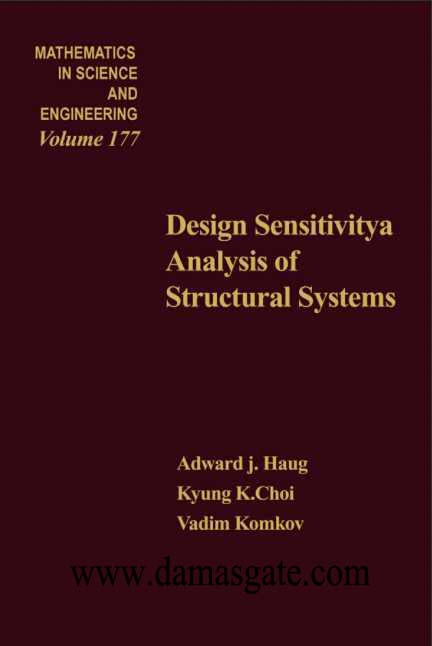Design Sensitivity Analysis of Structural Systems

Design Sensitivity Analysis
of Structural Systems
This is Volume 177 in
MATHEMATICS IN
SCIENCE AND ENGINEERING
A Series of Monographs and Textbooks
Edited by WILLIAM F. AMES,
Georgia Institute of Technology
The complete listing of books in this series is available from the Publisher
upon request.
Preface
Structural design sensitivity analysis concerns the relationship between
design variables available to the engineer and structural response or state
variables that are determined by the laws of mechanics. The dependence of
structural response measures such as displacement, stress, natural frequency,
and buckling load on design variables such as truss member crosssectional
area, plate thickness, and component shape is implicitly defined through the state equations
ofstructural mechanics. Attention is restricted in
this text to linear structural mechanics; i.e., to structures whose governing
equations (matrix, ordinary differential, or partial differential) are linear in
the state variables, once the design variable is fixed. Since design variables
appear in the coefficients oflinear operators, however, the state equations
are nonlinear as functions of state anddesign. The mathematical challenge is
to treat the nonlinear problem ofdesign sensitivity analysis with methods
that take advantage of mathematical properties ofthe linear (for fixed design)
state operators.A substantial literature on the technical aspects
ofstructural design sensitivity analysis exists. Some is devoted directly to the subject,
but most is imbedded in papers devoted to structural optimization. The premise
ofthis text is that a comprehensive theory ofstructural design sensitivity analysis
for linear elastic structures can be treated in a unified way. The objective of
the text is to provide a complete treatment of the theory and numerical
methods of structural design sensitivity analysis. The theory supports optimality
criteria methods ofstructural optimization and serves as the foundation for iterative methods
ofstructural optimization. One ofthe most common
methods ofstructural design involves decisions made by the designer,
based on experience and intuition. This conventional mode of structural
design can be substantially enhanced ifthe designer is provided with design
sensitivity information that explains what the influence ofdesign changes
will be, without requiring trial and error.
The advanced state ofthe art offinite element structural analysis provides
a reliable tool for evaluation ofstructural designs. In its present form, however,
it is used to identify technical problems, but it gives the designer little
help in identifying ways to modify the design to avoid problems or improve
desired qualities. Using design-sensitivity information that can be generated
by methods that exploit the finite-element formulation, the designer can
carry out systematic trade-offanalysis and improve the design. The numerical
efficiency of finite-element-based design sensitivity analysis and the
emergence ofinteractive graphics technology and CAD systems are factors
that suggest the time is right for interactive computer-aided design ofstructures,
using design sensitivity information and any of a variety of modem
optimization methods. It is encouraging to note that as ofSeptember 1983, the
MacNeal-Schwendler Corporation introduced one ofthe design sensitivity
analysis methods presented in Chapter 1in NASTRANfinite element
code. It is hoped that this represents a trend that will be followed by other
codes. In addition to developing design sensitivity formulas and numerical
methods, the authors have attempted to present a unified and relatively
complete mathematical theory ofstructural design sensitivity analysis. Recent
developments in functional analysis and linear operator theory provide
a foundation for rigorous mathematical analysis ofthe problem. Inaddition
to fulfilling one's instincts to be accurate, complete, and pure of heart, the
mathematical theory provides valuable insights and some surprisingly practical
results. The mathematical theory shows that positive definiteness (actually
strong ellipticity) of the operators of structural mechanics for stable
elastic structures is the property that provides most ofthe theoretical results
and makes numerical methods work. In the case of repeated eigenvalues,
which are now known to arise systematically in optimized designs,
the theory shows that repeated eigenvalues are not generally differentiable with respect
to design, but are only directionally differentiable. Erroneous results that
have appeared in the literature under the assumption ofdifferentiability can
now be corrected. Since such pathological problems and dangers lurk in
broad classes ofoptimum structures, it is hoped that the mathematical tools
presented in this text will help in constructing truly optimum structures that
do not have mathematically induced flaws.
The authors have attempted to write this text to meet the needs ofboth the
engineer who is interested in applications and the mathematician and theoretically
inclined engineer who are interested in the mathematical subtleties
ofthe subject. Toaccomplish this objective, each chapterhas been written to
Download
http://s18.alxa.net/s18/srvs2/01/Des...al.Systems.rar